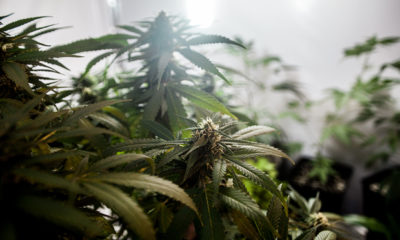
Economics
California Cannabis Taxes Cut; Prices Likely to Stay the Same
California’s legal cannabis industry received some badly needed tax relief, but lawsuit threats, a political shell game and government’s addiction to cannabis taxes limited the win.
After years of increasingly desperate pleas for relief from burdensome California cannabis taxes that jeopardize the entire marijuana legalization experiment, the state’s cannabis industry—the oldest and still the largest marijuana market in the US—finally got something of a break in late June. However, consumers may not notice, as most California cannabis taxes remain in place.
In a late-night session, as part of a package of other last-minute reforms, the California state Legislature voted to approve AB 195, a bill that would eliminate the state’s “cultivation tax.” Gov. Gavin Newsom is expected to sign the bill into law.
A regressive, per-ounce, pre-sale levy on just-harvested cannabis plants that equated in some situations to a pre-sale levy of up to 77%, the cultivation tax was blamed by small craft farmers for making their product uncompetitive with the persistent illicit market—and made legal independent cannabis cultivation an unsustainable business.
“It’s a good first step towards genuine reform,” said Amy Jenkins, a Sacramento, Calif.-based lobbyist who worked on passing the bill. “But there’s still a lot more work to do.”
Axing the loathed cultivation tax is indeed a win, several observers told Cannabis Now. But it’s a limited win. Most businesses will still be crying out for tax and regulatory relief in a year’s time, provided they last that long.
Worse, consumers will barely notice the bill passed—if they notice at all.
“Revenue Neutral”
The state’s 15% excise tax will remain in place for at least another three years. And since the excise tax will now be collected at the point of sale rather than at wholesale, the amount of money collected by the state will stay roughly the same—a doctrine known in Sacramento as “revenue neutrality.”
Despite an historic budget surplus of nearly $100 billion, maintaining that neutrality was paramount. No neutrality, no bill, a doctrine that Gov. Gavin Newsom’s office accepted as gospel—in part because several interest groups, beneficiaries of the nearly $650 million in annual taxes set aside from cannabis sales, made it clear to the governor, lawmakers and other stakeholders if that revenue stream guaranteed under 2016’s Prop. 64 went away, they would sue, several observers said.
This spelled the end for a separate, more ambitious reform bill, authored by Southern California state Sen. Steven Bradford, that would have cut the excise tax to a much more manageable five percent (although, significantly, local and county taxes would remain).
That means high retail prices for consumers—a large part of the reason why the illicit market is anywhere from three to five times as large as the legal market, depending on the estimate—will also stay roughly the same.
And small farmers wanted more than just relief from California cannabis taxes. They wanted the ability to sell directly to the consumer—or barring that, a wide expansion of cannabis retail. There are still almost nine cannabis cultivation permits for every retail permit, meaning the state’s oversupply problem that’s crashed wholesale prices will remain.
“This isn’t the relief the industry was looking for,” said Nara Dahlbacka, an Oakland, CA-based lobbyist who represented clients including small businesses and equity license-holders reserved for Black and brown entrepreneurs. “There’s not going to be a change in price for the cannabis consumer.”
But “the biggest losers in this bill,” she said, “are urban communities in California.”
The Magic Tax Game: Going Down, Staying Up
As for retailers, they wanted excise tax relief, in the form of a reduction or suspension of the state’s 15% excise tax. Not only will that tax remain in place until at least June 1, 2025, but that tax will now be collected at the retail level. And that amounts to a “tax increase,” said Jerred Kiloh, owner of the Los Angeles-based dispensary Higher Path and president of the United Cannabis Business Association, a lobby group for retailers.
Taxing products at the retail level rather than the wholesale level means a higher California cannabis tax levy, since wholesale prices are half or lower than a retail price. Applying the old salesman’s adage of buying for one and selling for two, it’s taxing at two rather than taxing at one.
“If we move excise tax collection to retail, then we have about an 11 to 15 percent excise tax rate increase,” Kiloh said in a recent analysis.
Further, the bill allows the state Department of Tax and Fee Administration to increase the excise tax every two years after July 1, 2025, if annual tax revenue falls below a $670 per year annual baseline to make up for the lost cultivation taxes. If revenue falls below that threshold, taxes will go up. And the cycle repeats itself.
Tax Credits, and More Enforcement Tools
Other provisions in the bill were welcomed. Equity retailers who received a fee waiver from the state Department of Cannabis Control are eligible to keep up to 20% of the excise taxes they collect, and equity operators may be able to claim tax credits of up to $10,000 per year.
There are also enforcement teeth in the bill: Illicit operators could be hit with a tax burden equal to what they’d owe “if they were operating in the legal market,” according to a state Senate bill analysis. And state and local governments will be able to punish landlords renting to illegal cannabis operations.
So, it’s certainly something, and more than has been achieved in the state to date. But California cannabis taxes will still be too high. Marijuana will still be too expensive. There are still too few places to buy legal cannabis, and equity entrepreneurs still lack access to capital and are hampered by high permit fees or regulatory burdens.
Imagine a patient who came into your emergency room bleeding out, who also couldn’t breathe, who was also dying of thirst. At least you recognized the patient was suffering, and at least you stemmed the bleeding, but you didn’t give them enough oxygen or a glass of water before discharging them from the hospital.
“What we’re seeing is the political will of the state starting to move in a direction that’s not in step with the time frame of the collapse that’s happening,” said Genine Coleman of the Origins Council, which advocates for small farmers. “We’re out of time for these half measures.”























